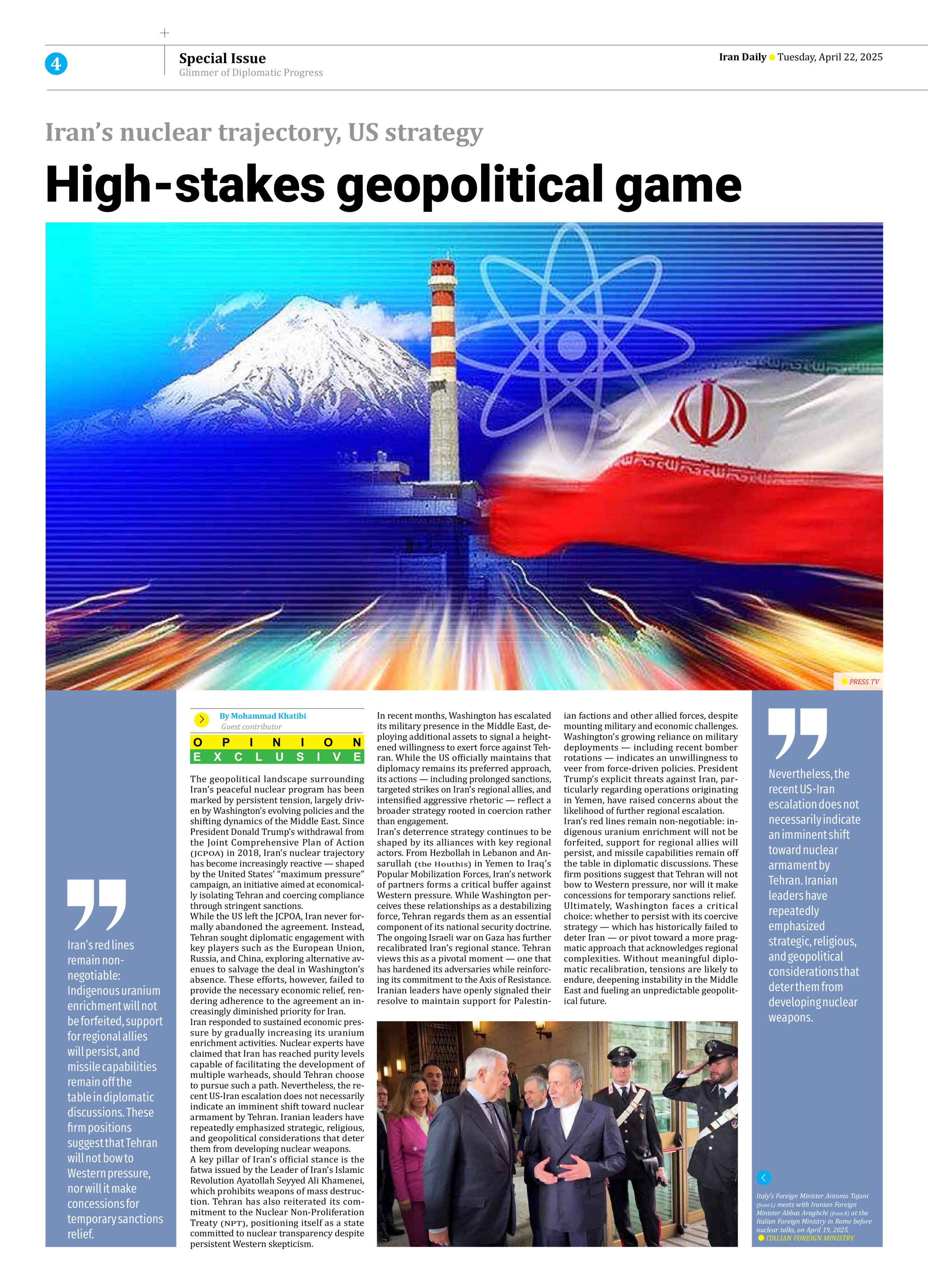
Iran’s nuclear trajectory, US strategy
High-stakes geopolitical game
By Mohammad Khatibi
Guest contributor
The geopolitical landscape surrounding Iran’s peaceful nuclear program has been marked by persistent tension, largely driven by Washington’s evolving policies and the shifting dynamics of the Middle East. Since President Donald Trump’s withdrawal from the Joint Comprehensive Plan of Action (JCPOA) in 2018, Iran’s nuclear trajectory has become increasingly reactive — shaped by the United States’ “maximum pressure” campaign, an initiative aimed at economically isolating Tehran and coercing compliance through stringent sanctions.
While the US left the JCPOA, Iran never formally abandoned the agreement. Instead, Tehran sought diplomatic engagement with key players such as the European Union, Russia, and China, exploring alternative avenues to salvage the deal in Washington’s absence. These efforts, however, failed to provide the necessary economic relief, rendering adherence to the agreement an increasingly diminished priority for Iran.
Iran responded to sustained economic pressure by gradually increasing its uranium enrichment activities. Nuclear experts have claimed that Iran has reached purity levels capable of facilitating the development of multiple warheads, should Tehran choose to pursue such a path. Nevertheless, the recent US-Iran escalation does not necessarily indicate an imminent shift toward nuclear armament by Tehran. Iranian leaders have repeatedly emphasized strategic, religious, and geopolitical considerations that deter them from developing nuclear weapons.
A key pillar of Iran’s official stance is the fatwa issued by the Leader of Iran’s Islamic Revolution Ayatollah Seyyed Ali Khamenei, which prohibits weapons of mass destruction. Tehran has also reiterated its commitment to the Nuclear Non-Proliferation Treaty (NPT), positioning itself as a state committed to nuclear transparency despite persistent Western skepticism.
In recent months, Washington has escalated its military presence in the Middle East, deploying additional assets to signal a heightened willingness to exert force against Tehran. While the US officially maintains that diplomacy remains its preferred approach, its actions — including prolonged sanctions, targeted strikes on Iran’s regional allies, and intensified aggressive rhetoric — reflect a broader strategy rooted in coercion rather than engagement.
Iran’s deterrence strategy continues to be shaped by its alliances with key regional actors. From Hezbollah in Lebanon and Ansarullah (the Houthis) in Yemen to Iraq’s Popular Mobilization Forces, Iran’s network of partners forms a critical buffer against Western pressure. While Washington perceives these relationships as a destabilizing force, Tehran regards them as an essential component of its national security doctrine.
The ongoing Israeli war on Gaza has further recalibrated Iran’s regional stance. Tehran views this as a pivotal moment — one that has hardened its adversaries while reinforcing its commitment to the Axis of Resistance. Iranian leaders have openly signaled their resolve to maintain support for Palestinian factions and other allied forces, despite mounting military and economic challenges. Washington’s growing reliance on military deployments — including recent bomber rotations — indicates an unwillingness to veer from force-driven policies. President Trump’s explicit threats against Iran, particularly regarding operations originating in Yemen, have raised concerns about the likelihood of further regional escalation.
Iran’s red lines remain non-negotiable: indigenous uranium enrichment will not be forfeited, support for regional allies will persist, and missile capabilities remain off the table in diplomatic discussions. These firm positions suggest that Tehran will not bow to Western pressure, nor will it make concessions for temporary sanctions relief.
Ultimately, Washington faces a critical choice: whether to persist with its coercive strategy — which has historically failed to deter Iran — or pivot toward a more pragmatic approach that acknowledges regional complexities. Without meaningful diplomatic recalibration, tensions are likely to endure, deepening instability in the Middle East and fueling an unpredictable geopolitical future.







